
60 Easy Science Experiments Using Materials You Already Have On Hand
- Subject:
- Chemistry
- Physical Science
- Physics
- Material Type:
- Activity/Lab
- Author:
- Jill Staake
- Posted Jill Staake
- Date Added:
- 02/01/2023

60 Easy Science Experiments Using Materials You Already Have On Hand

This is a worksheet on chemical equations and questions pertaining to the chemical equations.
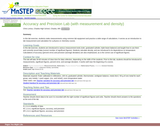
In this lab exercise, students practice correctly using measurement tools, recording data, calculating density, using significant figures, and exploring the concepts of accuracy and precision.
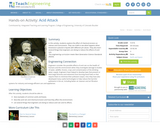
In this activity, students explore the effect of chemical erosion on statues and monuments. They use chalk to see what happens when limestone is placed in liquids with different pH values. They also learn several things that engineers are doing to reduce the effects of acid rain.

How do strong and weak acids differ? Use lab tools on your computer to find out! Dip the paper or the probe into solution to measure the pH, or put in the electrodes to measure the conductivity. Then see how concentration and strength affect pH. Can a weak acid solution have the same pH as a strong acid solution?

This activity is acid-base titration lab where students determine the percent of calcium carbonate in an eggshell.

This is a simulation activity that investigates acids and base chemistry. The simulation investigates ion concentration differences between strong & weak, acids & bases. This activity can be done in class, or as homework.

Application of structure and theory to the study of organic reaction mechanisms: stereochemical features including conformation and stereoelectronic effects; reaction dynamics, isotope effects and molecular orbital theory applied to pericyclic and photochemical reactions; and special reactive intermediates including carbenes, carbanions, and free radicals.
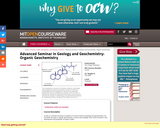
12.491 is a seminar focusing on problems of current interest in geology and geochemistry. For Fall 2005, the topic is organic geochemistry. Lectures and readings cover recent research in the development and properties of organic matter.
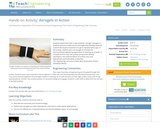
Students experiment with a new materialâaerogel. Aerogel is a synthetic (human-made) porous ultra-light (low-density) material, in which the liquid component of a gel is replaced with a gas. In this activity, student pairs use aerogel to simulate the environmental engineering application of cleaning up oil spills. In a simple and fun way, this activity incorporates density calculations, the material effects of surface area, and hydrophobic and hydrophilic properties.

These courses, produced by the Massachusetts Institute of Technology, introduce the fundamental concepts and approaches of aerospace engineering, highlighted through lectures on aeronautics, astronautics, and design. MIT˘ďď_s Aerospace and Aeronautics curriculum is divided into three parts: Aerospace information engineering, Aerospace systems engineering, and Aerospace vehicles engineering. Visitors to this site will find undergraduate and graduate courses to fit all three of these areas, from Exploring Sea, Space, & Earth: Fundamentals of Engineering Design to Bio-Inspired Structures

This is a series of activities demonstrating that air has mass, takes up space, and can exert a force on objects enough to lift them.

This is a series of investigations about air and its properties. How air exists all around us, and things it is capable of doing.

This is an inquiry activity that relies of pervious understanding of balancing and weighing to introduce a properties of air.

Students define and classify alloys as mixtures, while comparing and contrasting the properties of alloys to those of pure substances. Students learn that engineers investigate the structures and properties of alloys for biomedical and transportation applications. Pre- and post-assessment handouts are provided.

Acting as engineering teams, students take measurements and make calculations to determine the specific strength of various alloys and then report their data to the rest of the class. Using this class data, students write data-based recommendations to NASA regarding the best alloy to use in the construction of the engine and engine turbines for the Space Launch System that will eventually be used to transport astronauts to Mars.

A collection of lesson plans for middle school students. Content ranges from matter, density, and the periodic table to chemical changes and water molecules. The lessons range from informative to interactive. Simulations and videos are also included. Great resources for teachers!

This class analyzes complex biological processes from the molecular, cellular, extracellular, and organ levels of hierarchy. Emphasis is placed on the basic biochemical and biophysical principles that govern these processes. Examples of processes to be studied include chemotaxis, the fixation of nitrogen into organic biological molecules, growth factor and hormone mediated signaling cascades, and signaling cascades leading to cell death in response to DNA damage. In each case, the availability of a resource, or the presence of a stimulus, results in some biochemical pathways being turned on while others are turned off. The course examines the dynamic aspects of these processes and details how biochemical mechanistic themes impinge on molecular/cellular/tissue/organ-level functions. Chemical and quantitative views of the interplay of multiple pathways as biological networks are emphasized. Student work will culminate in the preparation of a unique grant application in an area of biological networks.
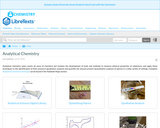
Analytical chemistry spans nearly all areas of chemistry but involves the development of tools and methods to measure physical properties of substances and apply those techniques to the identification of their presence (qualitative analysis) and quantify the amount present (quantitative analysis) of species in a wide variety of settings.
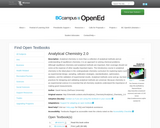
Analytical chemistry is more than a collection of analytical methods and an understanding of equilibrium chemistry; it is an approach to solving chemical problems. Although equilibrium chemistry and analytical methods are important, their coverage should not come at the expense of other equally important topics. The introductory course in analytical chemistry is the ideal place in the undergraduate chemistry curriculum for exploring topics such as experimental design, sampling, calibration strategies, standardization, optimization, statistics, and the validation of experimental results. Analytical methods come and go, but best practices for designing and validating analytical methods are universal. Because chemistry is an experimental science it is essential that all chemistry students understand the importance of making good measurements.